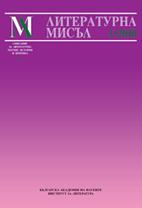“Истинският живот на Себастиан Найт” и “Николай Гогол” на Владимир Набоков – текстове на границата
“The Real Life of Sebastian Knight” and “Nikolai Gogol” by Vladimir Nabokov – Texts on the Border
Author(s): Reneta Bozhankova Subject(s): Literary Texts
Published by: Институт за литература - БАН
Keywords: “The Real Life of Sebastian Knight”; “Nikolai Gogol”; Vladimir Nabokov
Summary/Abstract: The novel “The Real Life of Sebastian Knight” (written in English in Europe in 1939 and published in America in 1941) has a peculiarly borderline position in the author’s life: it represents the first real creative step taken into the realms of the new language and focuses on the issue of the new language identity, on the trying on of masks and the tracing of the consequences of this change and play. This transition theme, as an aspect of the metamorphosis in its biological and metaphorical dimensions throughout the years, never stops occupying Nabokov, yet here it is most immediately outspoken, the novel being an attempt at solving a personal dilemma. Against the background of the transition theme’s intensive discussion by the characters and the plot, this novel can serve as a showcase for the whole “catalogue” of Nabokov’s techniques, themes, images. On the other hand, there is one of his subsequent texts, written in English already in the United States, aimed directly at the English speaking reading public and per definition being assigned to the genre of a writer’s biography – the book “Nikolai Gogol” (1942-1944). The study endeavours to see these two books from two standpoints in a parallel, outlining their similarities (while presuming identity), especially observing their modernistic nature of metaprose, of a text concerning the writing of a text, a text that is constantly regarding its own reflection in order to continue being written. The end of the 1930s and the beginning of the 1940s is a time of territorial, linguistic, aesthetic transitions and changes for Vladimir Nabokov. The momentary change of masks and scenes in the novel “Sebastian Knight” can only be attributed to high-class craftsmanship, already achieved earlier by Nabokov in his Russian language novels. The histrionic re-clothing and re-making up in this novel – “a second birth” – appear to be one of the rehearsals for the actual transformation from a Russian to an English speaking writer, from Sirin to V.Nabokov. V. is simply an intermediary phase in the metamorphosis. In this unstable environment Nabokov seeks for support, and finds it in the Russian classic Nikolai Gogol, who will lend him some of his legitimacy in the New World.
Journal: Литературна мисъл
- Issue Year: 2010
- Issue No: 1
- Page Range: 100-106
- Page Count: 6
- Language: Bulgarian
- Content File-PDF

